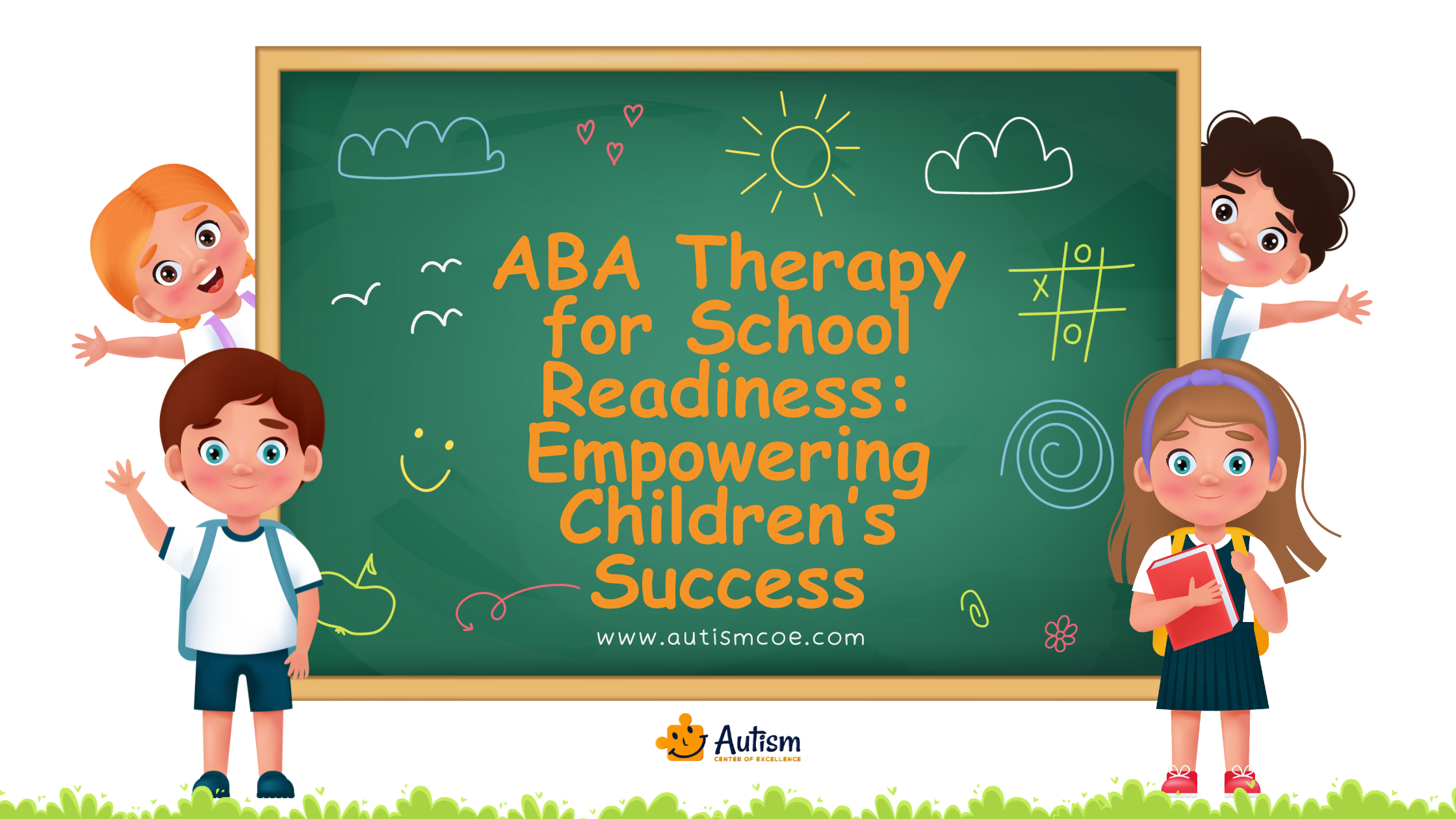Unit 3: ABA Therapy for School Readiness: Empowering Children’s Success

In the fast changing world, to prepare children for school is very important. Education is a cornerstone of their future introducing opportunities and personal development. Nevertheless, getting ready for the school day can be a big deal for children who are diagnosed with Autism Spectrum Disorder (ASD). Luckily, there is a very powerful instrument – it is called Applied Behavior Analysis (ABA) therapy. This blog will deal with the readiness issues, how ABA Therapy can help, parent tips, success stories, and the future.
The Importance of School Preparation
School entry is a critical period in the life of a child, determining their future academic and social development. This article elaborates on the critical role of Applied Behavior Analysis (ABA) therapy in establishing a good base, attending to special needs and managing anxiety for children in general and those with Autism Spectrum Disorder (ASD) in particular.
✅ Building a Strong Foundation: Indeed, the process of preparation for school can be likened to the setting of the initial bricks which will provide the entire building with its strength. The groundwork laid during the early years of a child greatly determines his or her academic and social growth. For children suffering from ASD, the well-structured base is of even greater importance and ABA therapy is the irreplaceable tool in creating the said base.
✅ Addressing Unique Needs In School: The learning needs and communication challenges of children with autism are usually unique. ABA therapy is an extremely focused approach, aimed at specific behaviors related to School Readiness. By concentrating on such aspects as communication, social interaction, and self-regulation, ABA enables these children to function effectively in a school setting.
✅ Reducing Anxiety At school through ABA Therapy: The entry to school can be overwhelming for any child, but when it comes to children with ASD, it is extremely difficult. ABA therapy helps in anxiety reduction by creating a predictable environment. It provides children with helpful mechanisms to be used in the school environment and helps them to deal with new experiences and schedules.

Why ABA Therapy is a Game Changer?
In this conversation, we investigate into what an impact applied behavior analysis (ABA) therapy has made for autism and what has made this approach so special. ABA therapy is a proven method, which is based on evidence and has been found to improve behavior and skill development in children with autism. Next, we will consider the grounds for its effectiveness, focusing on its evidence-based nature, specific interventions, and a significant role of caregivers in the therapy.
👉 ABA Helps Develop Essential Skills
ABA therapy focuses on individual behaviors and skills. It teaches people with ASD basic life skills including communication, social interaction and daily living activities. ABA breaks these skills into manageable steps, making learning more doable.
👉 ABA Promotes Social Skills
Social challenges are a characteristic of ASD. ABA interventions concentrate on teaching social skills such as turn-taking, eye contact, and social cues identification. This knowledge is vital for development of such skills that help the person build significant relationships and promote inclusion.
👉 ABA Improves Behavior Management
ABA is very effective in dealing with difficult behavior often associated with autism such as aggression, tantrums, and self-injury. The therapists apply behavior modification methods in order to eliminate the behavior tendencies and replace them with other more suitable ones, which results in a significant raise in the quality of life of the individual.
👉 ABA Enhances Communication
A lot of ASD patients have communication problems. ABA Therapy uses approaches such as discrete trial training (DTT) and naturalistic teaching to increase language development. This ability helps people to communicate their needs, wants and feelings, which in turn, reduces frustration and increases their ability to interact with other people.
What Parents Need to Know?
This informative section gives vital tips about what parents of children with Autism Spectrum Disorder (ASD) need to know when deciding to apply Applied Behavior Analysis (ABA) therapy. The ABA therapy is an effective approach, but knowing critical aspects of early intervention, choosing the appropriate provider and keeping the process consistent are vital to obtain the best result.
1. Early Intervention Matters :
Parents of children with ASD consider Early Intervention as nothing less than the utmost. The best time to start ABA is when the child is young. The overwhelming research supports the point that children who receive high quality ABA therapy at an early age are going to improve in many aspects making the school transition much easier.
2. Finding the Right Provider :
Choosing the appropriate ABA Therapy Provider is a decision of great importance. Parents should carefully seek professionals who are highly experienced in working with children who have autism. AutismCOE, which is backed by a committed set of professionals, is one of the leading providers of ABA Therapy Services that are carefully individualized for each child.
3.Patience and Consistency :
Consistency is one of the core principles of the ABA therapy. Parents should expect regular sessions and a life long commitment. It is important to realize that ABA therapy is not a one-time solution; it is a process that requires constant commitment and patience. The benefits, nevertheless, are invaluable.
Collaboration with Professionals & Educators
One aspect often ignored in the process of Preparing Children for School is the partnership between ABA (Applied Behavior Analysis) professionals and teachers. The combination of knowledge and skills from demand sides and supply sides could also turn the scale in the aspect of whether a child is prepared for the educational environment. This part is devoted to the fine-grained processes of such partnership and the formidable influence they may have on the child’s upbringing.
Individualization is one of the distinguishing features of ABA therapy. ABA professionals are experts In Developing Individualized treatment programs that are tailored to a child’s specific strengths, weaknesses, and goals. When cooperating with teachers, these customized plans stretch into the classroom situation.
Therapists and educators cooperate in designing Individualized Education Plans (IEPs) or 504 plans to link ABA techniques with academic goals. The plans set a system of support, accommodation, and goals that ensure that the child’s behavioral and educational requirements are in harmony.
ABA teachers and specialists should be involved in an organized and participative collaboration. ABA therapists are valuable resources for both teachers and specialists, giving tips on behavior management and interventions related to specific needs. Regular dialogue and team meetings is another element critical for partnership development.
Through sharing of observations and strategies, educators and ABA professionals can together overcome obstacles, implement uniform behavioral programs, and enhance the learning environment for the child. The combination of these two sets of professionals gives a holistic view of the child’s needs and provides the opportunity for real time alterations.

Frequently Asked Questions & Answer
What Is ABA Therapy, and How Does It Relate to School Readiness?
ABA therapy stands for Applied Behavior Analysis therapy. ABA therapy is a scientifically verified way to address changing behaviors and teach new skills. It also has to do with school readiness through dealing with developmental delays and behavioral issues in children promoting them advance to a lucrative school experience.
Why Is Preparing Children for School Significant?
Children’s preparation for school is an important moment because it sets the guidelines for their academic and social achievement. Early childhood development and readiness greatly affect on the child’s ability to adjust to the structured learning setting.
How Does ABA Therapy Personalize Its Approach for Each Child?
ABA therapy customizes its method by providing interventions based on the individual needs and abilities of each child. The child’s therapist together with the child creates an individual developmental plan.
What Should Parents Keep in Mind When Considering ABA Therapy for Their Child's School Readiness?
Parents should also open communication with ABA therapists, set realistic expectations for the child’s progress, as well as create a supportive environment at home that helps to maintain the skill sets learned in therapy.
Conclusion
School Readiness preparation in children is a critical part of their path to a successful future. ABA Therapy works wonders on the children with autism thus being a transformative power as it provides targeted interventions, evidence-based practices, and the promise of maximizing their ability. With the proper information, unyielding support and dedication, parents can accomplish the difficult journey and ensure that their children grow up to function well in the school and beyond. Led by AutismCOE, the unwavering captain of excellence, it stands as a loyal ally, supporting families at every stage of this journey.
Please Note: The content of this blog is for informational purposes only and should not be considered a substitute for professional medical advice, diagnosis, or treatment. Consult a qualified healthcare professional for personalized guidance tailored to your specific situation.

Bhavika Bhasin
Bhavika Bhasin is the Research and Marketing officer at AutismCOE. She works with children and adults with ASD. Her clinical research includes evaluating various available autism screening and diagnosis methods and their efficacy. She is currently developing a novel screening exam that is indicated to be more accurate than the existing available exams. She is also writes articles papers for various publications.

A Belief In Every Child’s Potential
Start your child’s individualized program for Autism Spectrum Disorder (ASD) to increase communication, social interaction, safety awareness, and independent living skills while reducing challenging behaviors.
